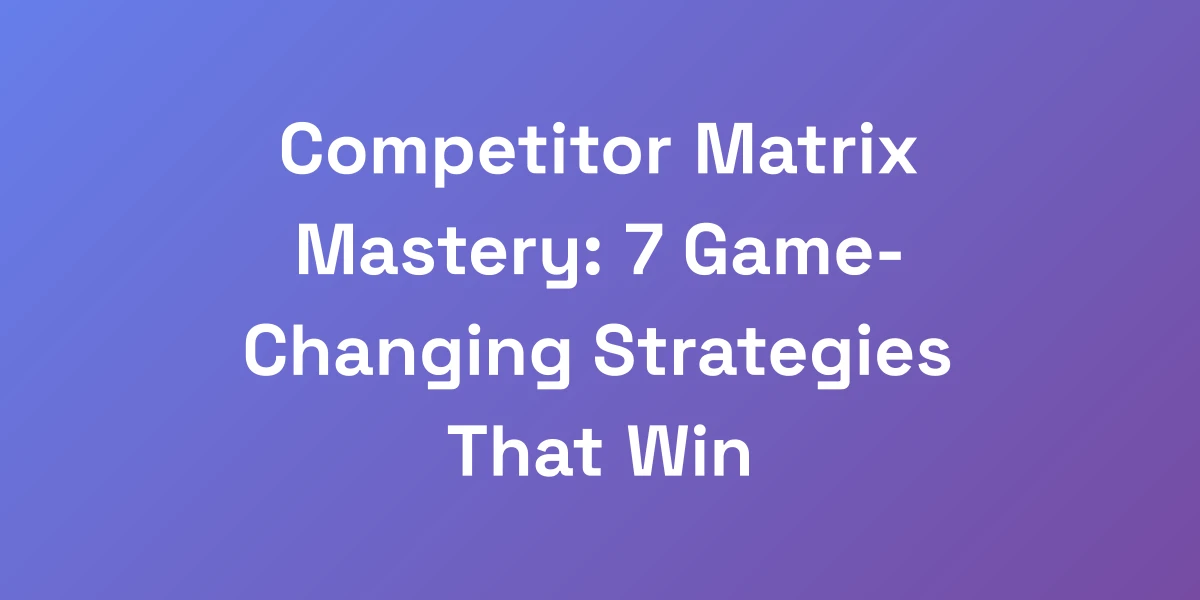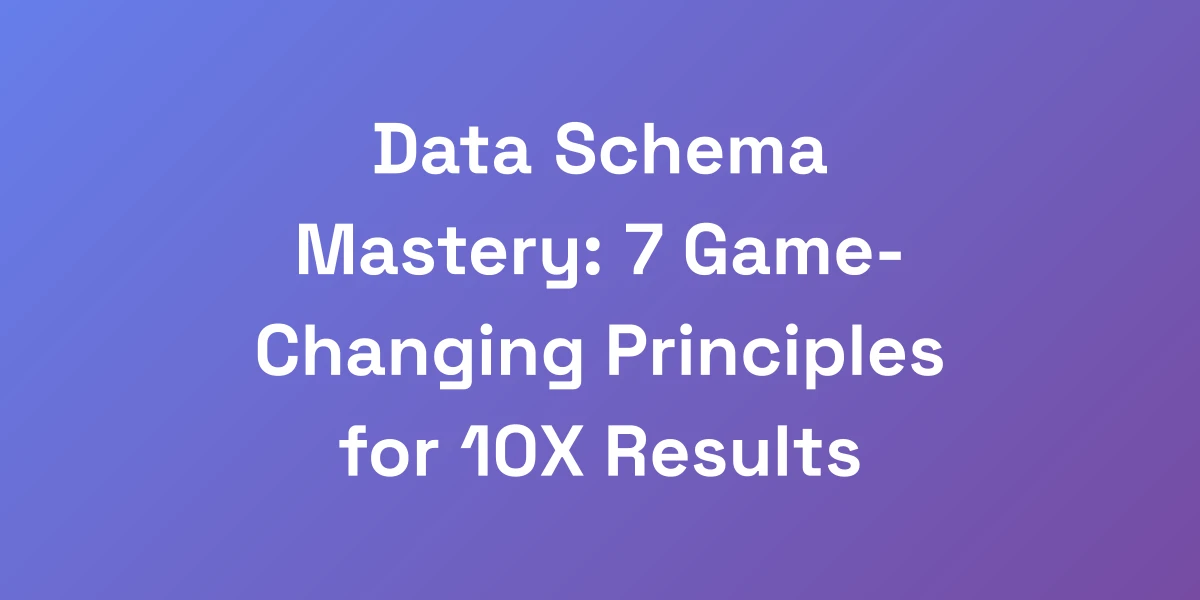Performance Tracking Mastery: 7 Game-Changing Strategies for 2025
Mar 11, 2025 | By [email protected]
Introduction
Ever felt like your business is running on autopilot, not sure where it’s heading or how to steer it towards success?
We’ve been there. The relentless hustle, the endless to-do lists, the constant juggling act—without a solid performance tracking system, it’s like trying to navigate a ship without a compass.
Performance tracking isn’t just a business buzzword; it’s the backbone of thriving enterprises. Yet, many are still burning money without even realizing it.
Imagine having a clear map that not only shows where you are but also lights up the most profitable paths forward. Sounds ideal, right? That’s exactly what mastering performance tracking can do for your business.
But here’s the kicker: It’s not about drowning in data. It’s about transforming the right metrics into actionable insights that drive real results.
Ready to revolutionize how you handle performance tracking in 2025? Let’s dive into the seven game-changing strategies that will set you apart from the competition.
This informative video on performance tracking provides a great introduction to the concepts we’ll be discussing.
The Million-Dollar Mindset Behind Performance Tracking
Let me be crystal clear – if you’re not tracking performance, you’re literally burning money. I’ve seen countless businesses throw away millions because they couldn’t connect the dots between measurement and money.
Here’s the raw truth: what gets measured gets managed, and what gets managed makes money. The difference between seven-figure businesses and those struggling to break even often comes down to one thing: their approach to performance tracking.
It’s not just about collecting data – it’s about creating a system that turns metrics into money.
Why Traditional Performance Metrics Are Dead
Traditional metrics like sales numbers and basic KPIs are no longer sufficient in today’s fast-paced market.
They offer a snapshot but lack the depth needed for strategic decision-making.
Relying solely on these outdated metrics means missing out on critical insights that drive growth.
- Limited scope: They don’t capture the full picture of business performance.
- Delayed feedback: By the time you act on traditional metrics, opportunities might have passed.
- Reactive rather than proactive: Traditional metrics often lead to firefighting instead of strategic planning.
To stay ahead, we need a new approach that goes beyond the basics and dives into the intricacies of performance data.
The Psychology of Performance Measurement
Understanding the human element behind performance metrics is crucial.
People respond differently to feedback and tracking systems, affecting overall productivity and morale.
By tapping into the psychology of measurement, we can design systems that motivate rather than discourage.
- Positive reinforcement: Celebrating small wins boosts morale and encourages continuous improvement.
- Constructive feedback: Providing actionable insights helps employees grow and excel.
- Transparency: Clear communication about metrics fosters trust and collaboration.
Integrating psychological principles into performance tracking systems ensures they are not only effective but also foster a positive work environment. According to employee engagement statistics, higher engagement correlates with better performance outcomes.
How Top 1% Companies Track Performance Differently
What sets the top 1% apart? It’s their unique approach to performance tracking.
They don’t just collect data—they analyze and act on it in ways that drive exponential growth.
- Advanced analytics: Utilizing AI and machine learning to gain deeper insights.
- Real-time tracking: Monitoring performance continuously rather than at set intervals.
- Integrated systems: Seamlessly combining various data sources for a holistic view.
These companies understand that sophisticated tracking systems are not optional—they’re essential for scaling effectively. As highlighted in what companies succeeding with AI do differently, leveraging artificial intelligence is a key differentiator.
The Hidden ROI of Systematic Performance Tracking
Performance tracking isn’t just about measuring success; it’s about uncovering hidden returns on investment.
By systematically tracking performance, businesses can identify inefficiencies and capitalize on strengths.
- Cost savings: Identifying areas where resources are wasted.
- Revenue growth: Pinpointing high-performing areas to allocate more resources.
- Employee retention: Enhancing engagement through meaningful performance insights.
The ROI of performance tracking extends beyond immediate financial gains, fostering long-term sustainability and growth. For more insights on marketing ROI metrics, refer to Gartner’s comprehensive analysis.
Breaking the “Too Busy to Track” Mindset
One of the biggest hurdles we face is the perception that tracking performance is time-consuming.
But here’s the deal: Not tracking performance is far more costly in the long run.
- Proactive problem-solving: Identifying issues before they escalate.
- Strategic planning: Making informed decisions based on accurate data.
- Operational efficiency: Streamlining processes through continuous improvement.
Shifting our mindset to prioritize performance tracking as an integral part of our workflow is essential for success. Implementing performance appraisal management software can streamline this process effectively.
Building Your Performance Tracking Framework
Listen up, because this is where most people mess up. They jump into tracking everything without a solid framework, and that’s like trying to build a house without a foundation.
You need a system that scales. I’ve personally tested dozens of frameworks with my portfolio companies, and I’m going to show you exactly what works.
The key is creating a framework that’s simple enough to execute daily but sophisticated enough to drive real results. This isn’t about complexity – it’s about consistency and clarity. Utilizing application performance monitoring software can provide the necessary tools to maintain this balance. Furthermore, incorporating AI autoblogging tools can automate content creation, enhancing your framework’s efficiency.
The 3-Tier Performance Tracking Pyramid
To build a robust performance tracking system, we can break it down into three essential layers:
- Strategic Metrics: High-level indicators aligned with long-term goals.
- Tactical Metrics: Mid-level metrics that track the progress of strategic goals.
- Operational Metrics: Day-to-day indicators that monitor everyday operations.
This pyramid ensures that every metric serves a purpose, from overarching goals to daily tasks, creating a cohesive and comprehensive tracking system.
Critical KPIs That Actually Matter
Not all KPIs are created equal. Focusing on the right indicators can make or break your performance tracking efforts.
- Customer Acquisition Cost (CAC): Measures the cost of acquiring a new customer.
- Customer Lifetime Value (CLTV): Estimates the total revenue a customer will generate over their relationship with your business.
- Employee Engagement Score: Assesses the level of employee commitment and satisfaction.
- Net Promoter Score (NPS): Gauges customer loyalty and the likelihood of referrals.
- Operational Efficiency Ratio: Evaluates how effectively resources are being utilized.
These KPIs provide a balanced view of your business’s health, covering financial performance, customer satisfaction, and internal operations.
Setting Up Your Performance Dashboard
A well-designed dashboard is the nerve center of your performance tracking system.
It should provide a clear, real-time overview of your critical metrics, enabling quick decision-making.
- Customization: Tailor the dashboard to display the KPIs that matter most to your business.
- Visualization: Use charts, graphs, and color-coding to make data easily digestible.
- Accessibility: Ensure that key stakeholders can access and understand the dashboard.
Investing time in setting up an effective dashboard pays dividends in clarity and efficiency.
Automation vs. Manual Tracking: When to Use Each
Deciding between automated and manual tracking isn’t a one-size-fits-all scenario. It requires a nuanced approach.
- Automation: Ideal for repetitive tasks and large data sets, reducing human error and saving time.
- Manual Tracking: Best for qualitative data and nuanced insights that require human judgment.
Balancing both methods ensures comprehensive coverage and optimal efficiency in your performance tracking. For example, utilizing automated SEO tools can significantly enhance your performance tracking system by automating repetitive SEO tasks.
Real-Time vs. Delayed Metrics: Finding the Sweet Spot
Real-time metrics offer immediate insights, allowing for swift action, while delayed metrics provide a broader perspective over time.
- Real-Time Metrics: Essential for monitoring activities that require instant responsiveness, such as website traffic or sales funnels.
- Delayed Metrics: Useful for trend analysis and long-term strategic planning, such as annual revenue or employee retention rates.
Finding the right balance between real-time and delayed metrics ensures that you’re agile yet strategic in your approach.
The Performance Data Revolution
The game has changed. We’re not in 2010 anymore where basic metrics cut it. In today’s market, the companies winning big are the ones leveraging data in ways their competitors haven’t even thought of.
I’m talking about predictive analytics, AI-driven insights, and performance correlation mapping. But here’s the kicker – it’s not about having more data. It’s about having the right data and knowing how to use it.
Let me show you how to turn data points into profit points. Check out this video on advanced data strategies to see these concepts in action.
Strategically leveraging content marketing for small businesses can align your performance metrics with your marketing efforts, ensuring that your content strategies are data-driven and effective.
Next-Generation Performance Metrics
To stay ahead, we need to embrace metrics that offer deeper insights and predictive capabilities.
- Predictive KPIs: Metrics that forecast future performance based on current trends and historical data.
- Behavioral Metrics: Indicators that track customer and employee behaviors to understand underlying motivations.
- Sentiment Analysis: Assessing the emotional tone behind customer feedback and employee surveys.
These advanced metrics provide a more nuanced understanding of your business dynamics, enabling proactive strategies.
AI and Machine Learning in Performance Tracking
Integrating AI and machine learning transforms performance tracking from a passive activity to an active strategy tool.
- Automated Insights: AI algorithms can identify patterns and anomalies that humans might overlook.
- Personalized Recommendations: Machine learning models can suggest tailored actions based on data analysis.
- Scalability: AI systems can handle vast amounts of data seamlessly, ensuring consistent performance tracking as your business grows.
Leveraging these technologies not only enhances accuracy but also empowers you to make data-driven decisions swiftly. For a deeper understanding of AI cost analysis for GRC, visit Granica AI’s insightful blog.
Predictive Performance Analytics
Predictive analytics takes performance tracking to the next level by forecasting future trends and outcomes.
- Trend Forecasting: Anticipate market shifts and adjust strategies accordingly.
- Risk Management: Identify potential risks before they become critical issues.
- Resource Allocation: Predict future resource needs to optimize budgeting and staffing.
By anticipating what’s next, you can stay one step ahead, turning uncertainties into opportunities.
Cross-Department Performance Correlation
Understanding how different departments influence each other is key to holistic performance management.
- Interconnected Metrics: Track how changes in one area impact others, such as marketing efforts influencing sales performance.
- Integrated Reporting: Consolidate data from various departments to get a comprehensive view of organizational performance.
- Collaborative Insights: Encourage departments to share insights and work together towards common goals.
These correlations help in identifying synergies and mitigating conflicts, fostering a more cohesive business strategy.
Data Visualization Techniques That Drive Action
Data is only as good as its interpretation. Effective visualization turns complex data into actionable insights.
- Interactive Dashboards: Allow users to explore data dynamically, uncovering deeper insights.
- Infographics: Simplify complex information into easily digestible visuals.
- Heat Maps: Highlight areas of significant activity or concern, guiding strategic focus.
By presenting data visually, you make it easier to understand, communicate, and act upon.
Leveraging Employee Engagement for Superior Performance Tracking
Employee engagement is the linchpin of effective performance tracking. When your team is engaged, performance metrics become more meaningful and actionable.
We’ve seen companies like Rexall transform their performance tracking by focusing on employee engagement, leading to significant improvements in productivity and retention.
Integrating Engagement Metrics into Performance Tracking
To truly master performance tracking, integrating employee engagement metrics is non-negotiable.
- Engagement Surveys: Regularly assess employee satisfaction and identify areas for improvement.
- Feedback Loops: Create mechanisms for continuous feedback between employees and management.
- Recognition Programs: Track the effectiveness of employee recognition and reward systems.
These metrics not only provide insights into employee morale but also highlight factors that drive or hinder performance.
Boosting Productivity Through Engagement
Engaged employees are inherently more productive. Here’s how to leverage engagement for better performance:
- Clear Goals: Ensure that employees understand their roles and how they contribute to the company’s objectives.
- Professional Development: Invest in training and growth opportunities to keep your team motivated and skilled.
- Work-Life Balance: Promote a healthy balance to prevent burnout and maintain long-term productivity.
When employees are engaged, they’re not just working harder—they’re working smarter and more effectively.
Embracing Continuous Performance Management
Gone are the days of annual reviews and static performance assessments. Continuous performance management is the future.
It’s about ongoing conversations, real-time feedback, and agile adjustments that keep your team aligned and moving forward.
Real-Time Feedback Mechanisms
Implementing real-time feedback transforms performance tracking from a periodic task to a dynamic process.
- Instant Recognition: Acknowledge achievements as they happen to boost morale and motivation.
- Immediate Course Correction: Address issues promptly before they escalate.
- Enhanced Communication: Foster an open dialogue between employees and managers.
Real-time feedback ensures that performance management is continuous and responsive, not just a yearly obligation.
Agile Goal Setting and Tracking
Agility in goal setting allows your team to adapt to changing circumstances and stay aligned with your business objectives.
- Flexible Goals: Adjust targets based on real-time data and market conditions.
- Short-Term Milestones: Break down long-term goals into manageable, short-term tasks.
- Regular Check-Ins: Schedule frequent reviews to monitor progress and make necessary adjustments.
This approach keeps your team focused and adaptable, ensuring that performance tracking remains relevant and effective.
Technology-Driven Performance Management Tools
Leveraging the right technology is essential for continuous performance management.
- Performance Management Software: Utilize tools that facilitate real-time tracking and feedback.
- AI-Powered Insights: Employ AI to analyze performance data and provide actionable recommendations.
- Mobile Accessibility: Ensure that performance tracking tools are accessible on-the-go, promoting inclusivity and flexibility.
These tools streamline the performance management process, making it more efficient and effective. Additionally, implementing marketing automation for agencies can further enhance your performance tracking by automating marketing campaigns and client management tasks.
Fostering a Culture of Continuous Improvement
Performance tracking should be a catalyst for ongoing improvement, not just a means of evaluation.
- Encourage Experimentation: Promote a mindset where trying new approaches is welcomed and failure is seen as a learning opportunity.
- Empower Employees: Give your team the autonomy to make decisions and take ownership of their performance.
- Celebrate Progress: Recognize and reward incremental improvements to maintain momentum and motivation.
A culture of continuous improvement ensures that performance tracking drives sustained growth and innovation.
Advanced Data Security and Privacy in Performance Tracking
As we dive deeper into performance tracking, data security and privacy become paramount.
With the increasing reliance on data-driven strategies, safeguarding sensitive information is not just a legal requirement but a trust factor.
Here’s how to ensure your performance tracking systems are secure and respect privacy:
Implementing Robust Data Protection Measures
Protecting data is non-negotiable. Implementing robust data protection measures is essential to safeguard your business and your employees.
- Encryption: Encrypt data both in transit and at rest to prevent unauthorized access.
- Access Controls: Restrict data access based on roles and responsibilities.
- Regular Audits: Conduct periodic security audits to identify and mitigate vulnerabilities.
These measures ensure that your performance data remains secure and confidential.
Compliance with Data Privacy Regulations
Adhering to data privacy regulations is crucial for maintaining trust and avoiding legal repercussions.
- GDPR and CCPA Compliance: Ensure that your performance tracking practices comply with major data privacy laws.
- Data Minimization: Collect only the data that is necessary for performance tracking.
- User Consent: Obtain explicit consent from employees and customers before collecting and using their data.
Compliance not only protects your business but also enhances your reputation as a trustworthy organization.
Ethical Use of Performance Data
Using performance data ethically is essential for fostering a positive workplace culture.
- Transparency: Clearly communicate how performance data is collected, used, and shared.
- Fairness: Ensure that data-driven decisions are fair and unbiased.
- Respect Privacy: Protect employee and customer privacy by anonymizing data when possible.
Ethical data practices build trust and encourage a more open and collaborative work environment.
Securing Employee Trust in Data Practices
Employees are more likely to engage with performance tracking systems if they trust that their data is being handled responsibly.
- Open Communication: Discuss data practices openly and address any concerns employees may have.
- Inclusive Policies: Involve employees in the creation and implementation of data policies.
- Consistent Practices: Apply data security measures uniformly across the organization.
Building and maintaining trust is key to successful performance tracking and overall organizational health.
Maximizing the ROI of Your Performance Tracking Systems
Investing in performance tracking systems can yield substantial returns, but only if leveraged correctly.
Here’s how to maximize the ROI of your performance tracking investments:
Aligning Tracking Systems with Business Goals
Your performance tracking systems should be directly aligned with your business objectives.
- Strategic Alignment: Ensure that the metrics you track support your short-term and long-term goals.
- Goal-Oriented Metrics: Focus on KPIs that have a direct impact on your business success.
- Regular Reviews: Periodically assess and adjust your tracking systems to remain aligned with evolving business goals.
Alignment ensures that every data point collected contributes to your overarching business strategy.
Optimizing Resource Allocation Based on Performance Data
Effective resource allocation is a direct benefit of robust performance tracking.
- Identify High-Impact Areas: Allocate more resources to areas that are driving significant results.
- Eliminate Waste: Use data to identify and cut down on inefficient processes and expenditures.
- Strategic Investments: Invest in areas with the highest potential for growth and ROI.
Optimizing resource allocation based on performance data ensures that your investments are driving maximum value.
Continuous Improvement Through Iterative Feedback
Performance tracking should be a continuous loop of feedback and improvement.
- Iterative Processes: Regularly refine your performance tracking methods based on feedback and results.
- Adaptive Strategies: Be willing to pivot and adjust strategies as new data and insights emerge.
- Learning and Development: Use performance data to guide training and development initiatives for your team.
This iterative approach fosters a culture of continuous improvement, driving sustained business growth.
Case Studies: Businesses Thriving with Performance Tracking
While specific case studies were not provided, the impact of effective performance tracking is evident across various industries.
Companies like Nestle have implemented continuous performance management software, leading to ongoing feedback and performance coaching, which significantly boosted employee productivity and modernized HR processes.
Similarly, Panasonic Energy North America utilized AI to enhance maintenance processes, reducing machine downtime and increasing throughput.
- Rexall: Improved employee engagement and Net Promoter Scores through performance tracking tools.
- Panasonic: Leveraged AI-driven insights to optimize maintenance and operational efficiency.
These examples illustrate how strategic performance tracking can transform business operations and drive substantial growth.
Conclusion
Mastering performance tracking is not a luxury; it’s a necessity for businesses aiming to thrive in 2025 and beyond.
We’ve explored seven game-changing strategies that can transform how you measure, manage, and maximize your business performance.
From building a solid tracking framework and embracing advanced analytics to fostering employee engagement and ensuring data security, each strategy offers a pathway to greater efficiency and profitability.
But remember, performance tracking is not a one-time setup—it’s an ongoing journey of continuous improvement and adaptation.
Ready to take your performance tracking to the next level? Start implementing these strategies today and watch your business unlock its full potential.
What challenges are you facing with your current performance tracking systems? Share your thoughts and let’s discuss how to overcome them together.








